Pumpkin Geometry: Stunning Shadow Sculptures That Illuminate an Ancient Mathematical Technique
Like a Halloween pumpkin, the hollow sphere casts a dramatic shadow across the room.
The curved lines on the spherical shell magically produce a grid of perfect squares. It would make for an amazing lampshade, or maybe even a disco ball.
The light sculpture is also a very cool reinterpretation of some ancient geometry. It’s illuminating – in both senses of the word.
Consider what the sculpture is doing. Light from a single source (at what would be the North Pole) hits a three-dimensional shape (the spherical shell) and then produces a two-dimensional image (the shadow pattern).
In other words, the shadow is a 2D map of the 3D sphere. Formally, we call it a stereographic projection. Cartographers and astronomers have long used this method to draw maps of the Earth and the sky.
The image below, for example, is a stereographic projection of the globe from the North Pole.
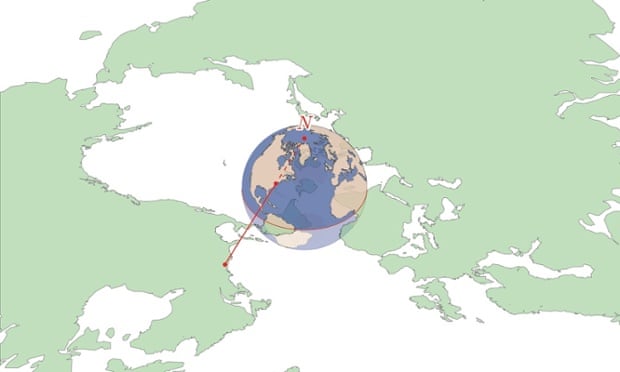 The red line shows a straight line from the North Pole through New York and on to the flat map of the world, analogous to the path of light from a source at N. Illustration: Henry Segerman
The red line shows a straight line from the North Pole through New York and on to the flat map of the world, analogous to the path of light from a source at N. Illustration: Henry Segerman
Scientists would originally have used pencil and paper, and more recently computers, to draw the maps. The idea of using light and shadow is an innovation of the mathematicians Henry Segerman, of Oklahoma State University, and Saul Schleimer, of the University of Warwick.
Usually you start with a pattern on a sphere, and then see the map it produces. Henry thought it would be fun to do it the other way around: to start with the map, and then work out the pattern on the sphere.
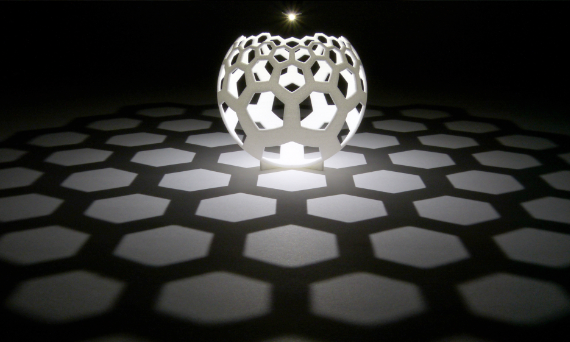 Hex my pumpkin. Photograph: Henry Segerman
Hex my pumpkin. Photograph: Henry Segerman
He first chose a square grid, and using design software worked out the shell pattern that would produce it. Next up he chose the hexagonal grid. I love this one since the pattern of shrinking hexagons looks very organic, a sort of cocoon.
Now for the maths bit. What’s interesting about stereographic projections – and why they are important – is that all the angles on the sphere are preserved on the shadow.
Maps made using stereographic projection will massively distort the sizes of countries (as we saw above) yet since the angles are preserved these maps are of more use for navigators.
It is hard to see without looking closely, but the angles in the first spherical model (which produces the square grid) are all 90 degrees, even though the lengths of the sides are all different, and the angles in the second spherical model (which produces the hexagons) are all 120 degrees.
“Stereographic projection is a beautiful and important idea, and these models show how it works in an immediately understandable way,” says Saul. “I think people respond even better to a real-life physical demonstration than a computer animation - you can’t cheat when it’s something as simple as light and shadow!”
Henry and Saul then turned to a well-known spherical tiling, called a (2,3,5) tiling, made up of triangles, but arranged to make diamonds, larger triangles and pentagons. They discovered that in the nineteenth century, the German mathematician August Möbius - yes, he of the eponymous strip - had drawn a sketch of how the tiling would look under a stereographic projection. Henry and Saul decided to make it.
“Maybe the only reason it hadn’t already been done before 3D printing is that any errors in the geometry get magnified, so you need a very precise way to make the model,” Henry says.
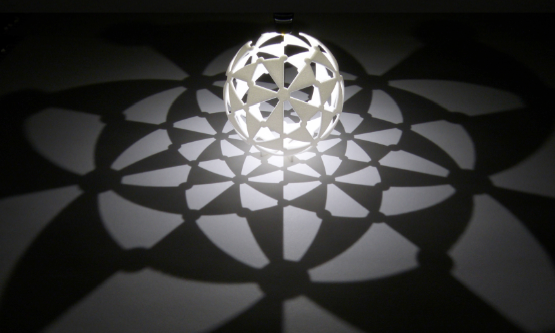 The (2-3-5) tiling. Photograph: Henry Segerman
The (2-3-5) tiling. Photograph: Henry Segerman
If you look carefully, the spherical design is made of diamond, triangular and pentagonal propellers. The large circles are at the centre of the pentagons, and the small circles are at the centre of the diamonds and the triangles. (The circles are there to make the structure sturdy – they aren’t part of the geometry of the tiling).
Not only angles, but circles are also preserved. The circles on the sphere become perfectly circular shadows.
Henry and Saul made a similar design based on Möbius’s design: the big circles enclose pentagons and the small ones triangles. Gorgeous!
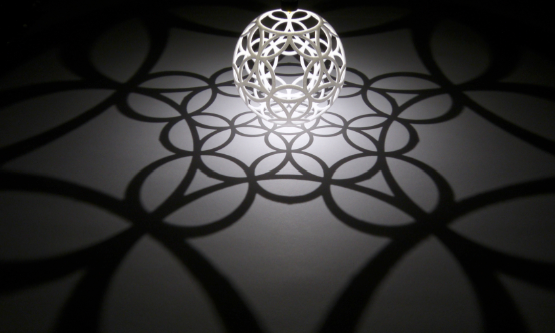
Mobius imperious. Photograph: Henry Segerman
Having done triangles, squares, pentagons and hexagons, there was only one way to go: heptagons.
It is impossible to create a pattern of identical heptagons around a sphere for reasons that were known to the Greeks, and which you will have to accept or read about here.
So, Henry and Saul decided to make a 3D-printed model of the hyperbolic plane. Again, this isn’t the place for a discussion of the hyperbolic plane – suffice it to say that it is a type of surface where parallel lines diverge because the surface is continually expanding.
If you already know about hyperbolic geometry you will dig how cute the sculpture is – and if you don’t just enjoy the pictures.
The hemisphere, in fact, provides four different hyperbolic models! Firstly, the hemisphere is itself a model.
Secondly, the classic stereographic projection provides what is known as the Poincaré disc model. (You might recognise this pattern from some Escher prints).
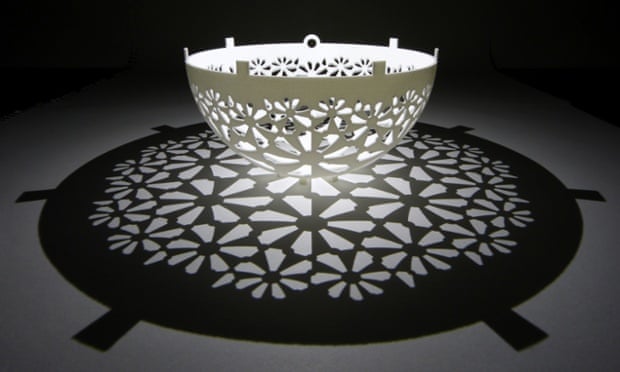 Hyperbolic hemisphere. Photograph: Henry Segerman
Hyperbolic hemisphere. Photograph: Henry Segerman
When the light source is at infinity, we get the Beltrami-Klein model.
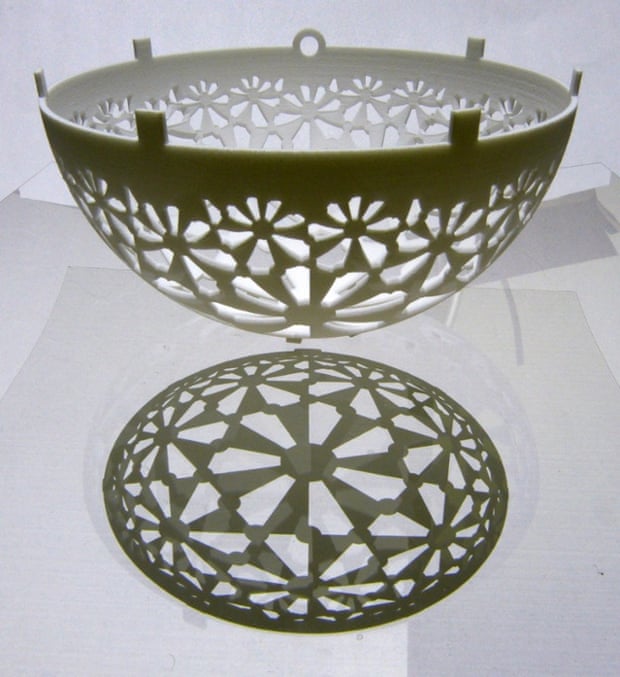 BK whopper. Photograph: Henry Segerman
BK whopper. Photograph: Henry Segerman
And when you put the light source at the equator and shine it against a wall, you get the Poincaré half-plane model.
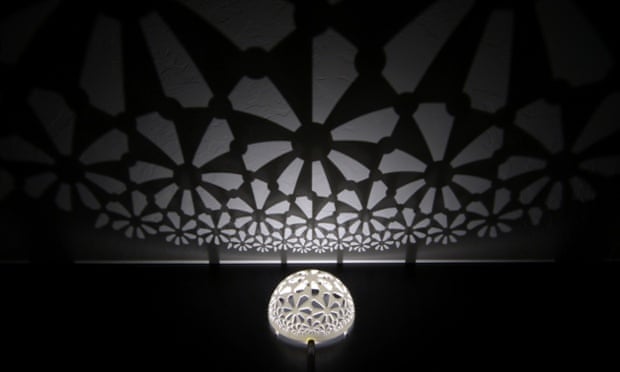 Le demi-Poincaré. Photograph: Henry Segerman
Le demi-Poincaré. Photograph: Henry Segerman
And sometimes at Halloween you get some ghosts.
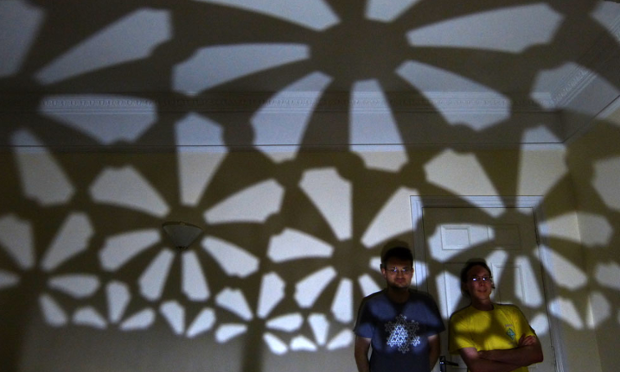 Henry Segerman and Saul Schleimer. Photograph: Henry Segerman
Henry Segerman and Saul Schleimer. Photograph: Henry Segerman
You can buy Henry and Saul’s stereographic models from Shapeways.
For more information, check out Henry’s personal site, YouTube channel and Thingiverse page.
If you want to be notified about new blog posts and related stuff please follow me on Facebook or Twitter.


Spread the word